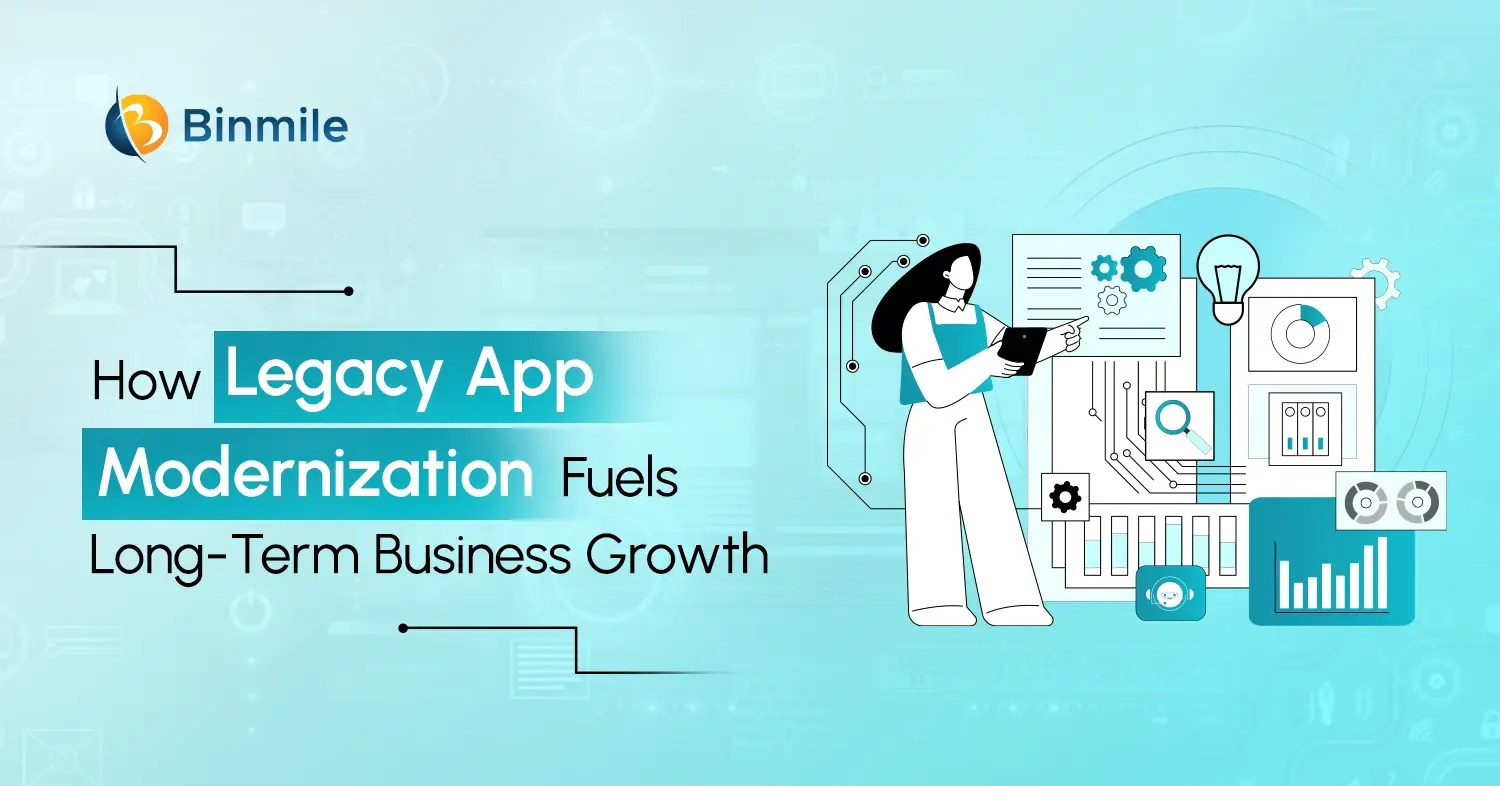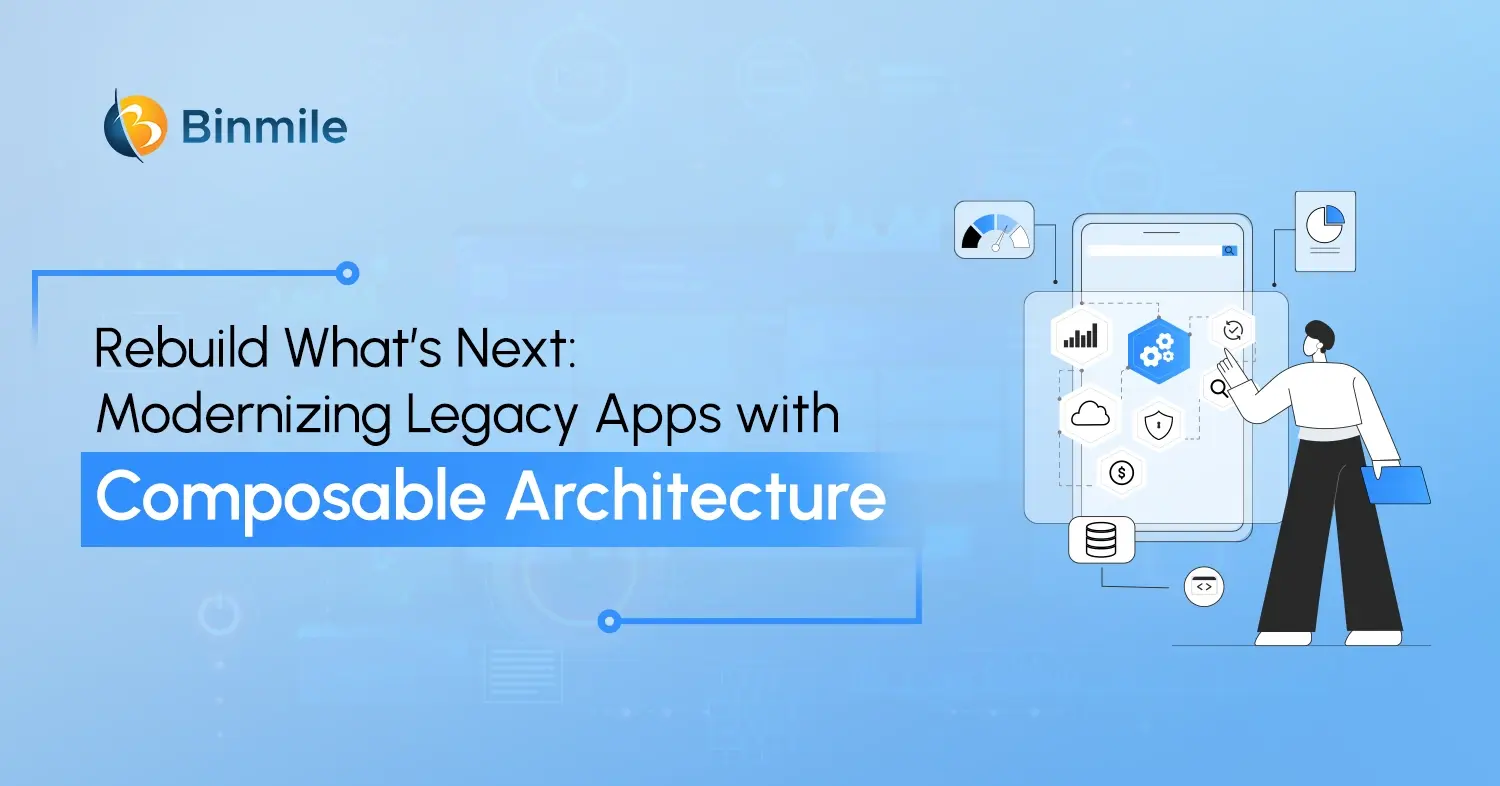Legacy software modernization has become essential for businesses aiming to transform operations and break growth barriers. In today’s dynamic environment, modernizing systems is vital to stay relevant and efficient secure. That’s why many companies now turn to software modernization services to overcome technical debt and unlock long-term value.
According to McKinsey (2024), 90% of businesses have adopted digital initiatives, emphasizing the need for IT modernization to remain competitive. IT digital transformation involves upgrading outdated systems and workflows to boost productivity and distribute intelligence across the organization. However, Businesswire (2020) reported that 74% of organizations started but didn’t complete legacy application modernization projects. CIO.com identified misalignment between technical and leadership teams as a critical barrier.
To drive growth through modernization, businesses must first identify the specific problem before initiating change. Just like Rome wasn’t built in a day, systems can’t be modernized all at once. A phased, strategic approach with a clear vision is essential. This blog provides a comprehensive guide to the legacy software modernization process, estimated costs, and key factors influencing pricing. But first, what does it mean to modernize legacy systems?
What is Legacy Systems?
A legacy system comprises outdated processes, software, and infrastructure. These systems often involve customer-owned, hosted, and supported technologies in monolithic, tightly integrated environments. While they remain functional, legacy systems are expensive to maintain and require rare IT expertise. Over time, they can hinder innovation.
Types of Legacy Systems
Legacy systems can vary widely depending on their architecture, technology, and usage. Some Common types include:
- Mainframe-Based Systems: Built on centralized mainframe architectures, often found in banking, insurance, and government sectors.
- Monolithic Applications: These are large, tightly coupled applications that lack modularity, making upgrades and integrations complex.
- On-Premises Software: Systems that require hardware and infrastructure on-site, making them harder to scale or integrate with cloud technologies.
- Custom-Built Solutions: Older custom-developed applications that no longer align with modern development practices or standards.
- Outdated ERP/CRM Platforms: These systems may have limited support, lack modern features, or struggle with integration.
Identifying your system’s type helps in selecting the most appropriate modernization approach.
What Does Mean by Legacy Software Modernizations?
Modernization means updating and optimizing softwaes to improve operations, eliminate technological constraints, enhance customer experience, and integrate with modern platforms. It becomes necessary when organizations must choose between maintaining costly, outdated infrastructure or upgrading to platforms better aligned with business goals. CIOs must assess when to modernize, where it will have the most impact, and how to minimize disruption and downtime.
When to Start Legacy Software Modernization: Key Indicators
You must thoroughly comprehend all of your current systems, evaluate the operation’s performance, and decide whether or not current technologies are adequate to meet your long-term goals. Here’s a list of 5 checkpoints for you to consider that can help organize your roadmap strategy. Consider asking the below questions:
- Can your current systems handle diverse data types from partner systems and internal software?
- To connect to new applications, do you need to modify integrations?
- Can you quickly handle the rising data quantities brought on by new applications?
- Can you quickly identify and correct data processing issues using your current IT systems?
- Does maintaining outdated infrastructure cost more than modernizing it?
If your answer to any or all of the above questions is a ‘yes’, then it’s time for your business to consider legacy systems modernization. Many businesses consider approaching a software development company to help initiate the process.
Key Strategies for Legacy Software Modernization: Two Proven Models
How obsolete software develops is influenced by numerous things. Sometimes adding just one line of code may suffice, while other times you may need to completely reimplement the solution. It’s essential to choose the correct approach right from the beginning. When considering techniques for legacy system modernization, there are two primary approaches: revolutionary and evolutionary. Let’s have a look at both of them:

1. Revolutionary Approach: Big Bang
It happens when your company develops a complete removal of the previous solutions. It resembles starting anything from scratch. You can move on to the next type if you think updating an existing system is risk-free, but this strategy is only appropriate for companies who are willing to take a chance on security issues, the loss of important data, or system unavailability. Then it makes sense to develop a fresh solution. If the original software is unable to manage business processes or resolve problems, the innovative approach is ideal.
2. Evolutionary Approach: Bad-Aid
This strategy aims to improve rather than build everything from scratch. Although it takes less time and effort, it is not always the best choice. However, there are fewer risks of data loss and downtime. This approach is more concerned with finding and removing the causes of problems than it is with really solving them.
Challenges & Considerations
Modernizing legacy software is not without its hurdles. Here are some common challenges businesses must navigate:
- Data Migration Complexity: Transferring data without loss or corruption can be difficult.
- Downtime Risks: Improper planning can lead to service interruptions.
- Knowledge Gaps: Few developers may understand outdated programming languages or platforms.
- Budget Overruns: Poor scope planning can lead to inflated costs.
- Resistance to Change: Employees accustomed to older systems may resist adopting new workflows.
- Regulatory Compliance: Ensuring the new systems comply with legal standards can be resource-intensive.
8-Step Process to Modernize Legacy Software in Your Organization
No matter what approach you choose, you need to have an action plan in place before you take a step. The more detailed your plan is the easier it’ll be for you to define success factors, allocate a budget, and define timelines for your project. You must have a clear project scope, one exact problem that you have identified in advance that you wish to address and a possible, thought-through solution to the problem. Let’s have a look at a step-by-step process to initiate legacy software modernization.

1: Analyze Your Business Objectives
- What changes are you aiming to implement?
- What are the company’s core objectives?
- What is the projected timeline for completion?
- Who are the key stakeholders involved?
- Which departments or processes might be affected?
At this initial stage, it’s essential to have clear, well-defined answers to these questions—mutually agreed upon and understood by the company’s leadership. Establishing a baseline is critical. To do this, track developer time, implement a help desk ticketing system, and document routine manual processes. Without a clear baseline, it becomes difficult to measure progress or align your modernization goals effectively.
2: Create a Roadmap
There are multiple approaches to implementing system changes, and selecting the right one depends on your application’s specific needs. Gartner outlines seven modernization options, ranked by ease of implementation—where simpler methods carry lower risk and business impact, while more complex methods involve greater risk and disruption.
- Encapsulate
- Rehost
- Replatform
- Refactor
- Rearchitect
- Rebuild
- Replace
By evaluating these seven approaches based on their impact on technology, architecture, functionality, cost, and risk, you can determine the most suitable modernization strategy for your organization.
3: Assess Technical Capability
What is your company’s current level of familiarity with the tools, operating models, and migration processes involved? If gaps exist, how do you plan to bridge them? To ensure smooth adoption, it may be necessary to provide employee training or engage external consultants to supplement internal capabilities. Clearly define your strategy for addressing these gaps to facilitate a successful transition to modern systems.
4: Define Modernization Goals
What is the goal of modernization? It is to provide and maintain a robust, modern infrastructure that supports business growth and operational efficiency. This process impacts every area of the organization, including IT systems and workflows. Regardless of your industry, there is always room for improvement, and modernization helps uncover and address these opportunities.
5: Evaluate Modernization Strategies
When deciding which of the seven modernization options to pursue, assess each based on more than just effort and impact. Key evaluation criteria include:
- Workload
- Architecture
- Cost (modernization and on-going operational)
- Risk
- Operations
- Security
The importance of these factors will vary depending on your organization’s specific needs. Additionally, evolving customer demands and market competitiveness should be considered when evaluating the true value of each strategy. As a result, attributes such as scalability and agility may carry greater weight in your decision-making process.
6: Prioritize Software Security
Security concerns are an ongoing priority during software modernization. How will your organization address these issues during upgrades? Every business must adhere to an established security framework, ensuring regular evaluation and compliance throughout the process. Hire software developers to determine the most effective strategies to secure applications, especially in the absence of traditional operating system protections.
Modernization projects that leverage container technologies typically incorporate Dynamic Application Security Testing (DAST) and Static Application Security Testing (SAST) within each deployed container. These tools allow developers to scan for security patches, outdated components, and known vulnerabilities both pre- and post-deployment. By embedding these security mechanisms within the application, organizations can also enable automated recovery of nodes in the event of a virtual host failure.
7: Adapt for Agility
Consumer expectations, market competition, economic fluctuations, and emerging technologies continuously reshape business operations. The average lifespan of software is approximately 6–8 years. Due to their often monolithic architecture, legacy systems restrict agility and make updates cumbersome.
In today’s digital landscape, organizations must be agile to deploy new features and respond to change quickly. Selecting the right modernization strategy requires determining the appropriate level of adaptability. While encapsulated applications can connect with microservices, they remain constrained by the limitations of their original codebase. In contrast, refactored or rearchitected software is better equipped to meet evolving business needs.
8: Leverage Expert Support
Most companies do not constantly develop or modernize software, as it is not their primary focus. Internal teams may lack the necessary expertise to operate in the “new” environment, which often requires additional training. As a result, there may not be enough internal resources to make all the critical decisions regarding modernization strategies, cloud adoption, or microservices support.
To overcome these challenges, many businesses turn to a trusted software partner for assistance. It is essential to choose a software development company with experience in re-engineering systems, processes, and technology using various modernization strategies. Additionally, look for a team that applies Agile and DevOps methodologies to accelerate the timeline of your modernization project.
Modernize your legacy systems with expert solutions – 74% of businesses struggle to upgrade outdated systems. Let’s change that!

Estimated Cost for Legacy Software Transformation
The cost of modernizing legacy software can vary significantly, depending on the complexity, scope, and approach. Generally, the costs range from $50,000 to $500,000+. Let’s look at the estimated costs for different levels of modernization:
- Minor Rehosting or Replatforming: $50,000 – $150,000
- Refactoring or Partial Modernization: $150,000 – $300,000
- Full System Rebuild: $300,000 – $500,000+
Also Read: Why Do App Modernization Projects Fail?
Crucial Elements Shaping the Cost of Legacy Software Transformation
Modernizing legacy software involves multiple cost-driving factors that businesses must consider to ensure proper budgeting and project execution. Below are the key factors influencing modernization costs:

1. Scope of Modernization
The scope of modernization refers to the size and extent of the changes required. If your modernization involves only minor updates (such as rehosting or replatforming), the cost will be lower. However, if you need a complete rebuild of the system, the cost will be much higher.
- Minor Changes: $50,000–$150,000 (e.g., rehosting, replatforming)
- Full Rebuild: $300,000–$500,000+ (for complete system replacement)
2. System Complexity
Older systems with custom code, multiple integrations, or outdated documentation require more time and expertise to update. The complexity of the legacy system will drive up the overall cost of modernization.
Expect a 30-40% increase in cost due to the additional time and effort required for testing, debugging, and integrating systems.
3. Technology Stack
The technology stack you select plays a key role in determining the cost of modernization. Modern technologies such as cloud-native platforms, microservices, and serverless architectures will increase the initial cost but offer scalability and long-term cost savings.
Implementing a modern stack can add 15-20% to the total modernization cost, depending on the technology’s complexity and scalability. Popular technology stacks and their associated costs include:
- Microservices Architecture: A distributed approach where each service operates independently, improving flexibility and scalability. This could cost an additional 15-20% compared to traditional monolithic designs.
- Cloud-Native Platforms: Leveraging cloud services like AWS, Google Cloud, or Microsoft Azure. These platforms provide scalability, but their initial cost can be higher due to infrastructure setup. Estimated additional cost: $20,000–$100,000 depending on the platform chosen.
- Serverless Architecture: Using services like AWS Lambda, Google Cloud Functions, or Azure Functions for computing power without the need to manage servers. Estimated additional cost: $10,000–$50,000 based on workload.
- Frontend: React, Angular, Vue.js (costs for development: $30–$150/hour depending on the region)
- Backend: Node.js, Python (Flask, Django), Java (Spring Boot) (costs for development: $40–$200/hour)
- Databases: PostgreSQL, MySQL, MongoDB (costs for setup and integration: $10,000–$30,000)
4. Data Migration
Data migration involves transferring data from legacy systems to modern systems, which can be time-consuming and costly. The more complex the data, the higher the cost of legacy software modernization.
Depending on the size and complexity, this could represent 20-30% of the total modernization cost. This includes the cost of cleaning and formatting data to make it compatible with the new system.
5. Security & Compliance
Ensuring security and compliance is critical, particularly for industries with strict regulations (like healthcare, finance, and retail). The process includes implementing security measures such as encryption, authentication, and regular audits, as well as ensuring that your systems comply with laws such as GDPR, HIPAA, and PCI DSS.
Compliance can add 10-25% to the overall cost, depending on the level of security required and the regulations your industry must adhere to.
6. Team Expertise & Location
The cost of the development team varies significantly based on their location and expertise. Here are average hourly rates based on region:
- US/Canada/Western Europe: $100–$250/hour
- Eastern Europe: $50–$120/hour
- Latin America: $50–$120/hour
- Middle-East: $50–$100/hour
- South Asia (India, Pakistan, Bangladesh): $25–$70/hour
- Africa: $20–$50/hour
Hiring teams in regions with lower hourly rates can significantly reduce the overall cost of the project while still maintaining quality.
Summing Up
The rules of the game are being dictated by the quickly changing digital environment for business owners. Therefore, to keep ahead of the competition and stay on the edge of technology, businesses must act quickly and frequently upgrade their IT systems. However, the assistance of a legacy software re-engineering company is required for a modernization program to be successful.
Your business does a major disservice in terms of productivity and development potential if you continue to use antiquated systems software. By updating it, you’ll be able to stay on top of the latest technology advancements, and give your business new development opportunities while maximizing income, process efficiency, and cost savings.
Frequently Asked Questions
Challenges associated with Legacy Software Modernization include:
- Complexity: Legacy systems may have intricate architectures, outdated technologies, and undocumented code, making modernization efforts challenging and time-consuming.
- Legacy Dependencies: Legacy systems may have dependencies on outdated hardware, software libraries, or third-party components that are difficult to replace or upgrade.
- Data Migration: Migrating data from legacy systems to modern platforms while ensuring data integrity, consistency, and security can be complex and error-prone.
- Business Disruption: Modernizing legacy systems may disrupt ongoing business operations, leading to downtime, productivity losses, and user dissatisfaction.
- Budget and Resource Constraints: Modernization projects require significant investments in terms of time, money, and resources, which may be limited or constrained by organizational budgets and priorities.
Legacy modernization techniques refer to various strategies and approaches used to update, migrate, or transform outdated or obsolete software systems, also known as legacy systems, into modern, efficient, and scalable solutions. These techniques aim to improve system performance, security, maintainability, and agility while leveraging contemporary technologies and development practices.
APIs help modernize legacy systems by connecting them with modern applications without needing a full rebuild. They enable data sharing, improve integration, reduce costs, and allow for gradual upgrades. This makes legacy systems more flexible, scalable, and compatible with current technologies.
The timeline varies based on system complexity and the chosen modernization strategy. It can range from a few months for minor upgrades to over a year for full system overhauls.
![Legacy Software Modernization: A Complete How-to Guide [Cost Included] Legacy Software Modernization Guide | Binmile](https://binmile.com/wp-content/uploads/2022/10/Legacy-Software-Modernization-Guide.webp)








